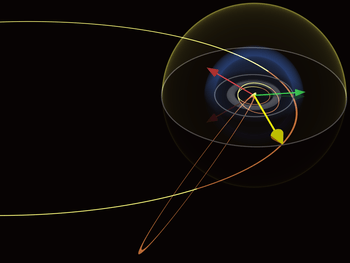Light-second
| Light-second | |
|---|---|
| Unit of | length |
| Unit conversions | |
| 1 light-second in ... | ... is equal to ... |
| SI units | 2.99792458×108 m |
| astronomical units |
0.0020040 AU 3.1688×10−8 ly 9.7156×10−9 pc |
| imperial/US units | 186282 mi |
The light-second is a unit of length useful in astronomy, telecommunications and relativistic physics. It is defined as the distance that light travels in free space in one second, and is equal to exactly 299792458 metres (just over 186282 miles).
Just as the second forms the basis for other units of time, the light-second can form the basis for other units of length, ranging from the light-nanosecond (just under one international foot) to the light-minute, light-hour and light-day, which are sometimes used in popular science publications. The more commonly used light-year is also presently defined to be equal to precisely 31557600 light-seconds, since the definition of a year is based on a Julian year (not Gregorian year) of exactly 365.25 days, each of exactly 86400 SI seconds.[1]
Use in telecommunications
Communications signals on Earth rarely travel at precisely the speed of light in free space, but distances in fractions of a light-second are still useful for planning telecommunications networks as they indicate the minimum possible delay between sender and receiver.
- One light-nanosecond is almost 300 millimetres (299.8 mm, 5 mm less than one foot[2]), which limits the speed of data transfer between different parts of a large computer.
- One light-microsecond is about 300 metres.
- The mean distance, over land, between opposite sides of the Earth is 66.8 light-milliseconds.
- Communications satellites are typically 1.337 light-milliseconds (low earth orbit) to 119.4 light-milliseconds (geostationary orbit) from the surface of the Earth. Hence there will always be a delay of at least a quarter of a second in a communication via geostationary satellite (119.4ms times 2); this delay is just perceptible in a transoceanic telephone conversation routed by satellite.
Use in astronomy

The light-second is a convenient unit for measuring distances in the inner Solar System, because it corresponds very closely to the radiometric data used to determine them (the match is not exact for an Earth-based observer because of a very small correction for the effects of relativity). The value of the astronomical unit (roughly the distance from the Earth to the Sun) in light seconds is a fundamental measurement for the calculation of modern ephemerides (tables of planetary positions): it is usually quoted as "light-time for unit distance" in tables of astronomical constants, and its currently accepted value is 499.004786385(20) s.[3][4]
- The mean diameter of the Earth is about 0.0425 light-seconds.
- The average distance from the Earth to the Moon is about 1.282 light-seconds.
- The diameter of the Sun is about 4.643 light-seconds.
- The average distance from the Earth to the Sun is 499.0 light-seconds.
Multiples of the light-second can be defined, although apart from the light-year they are more used in popular science publications than in research works. For example, a light-minute is 60 light-seconds and the average distance from the Earth to the Sun is 8.317 light-minutes.
| Unit | Definition | Distance | Example | ||
| m | km | miles | |||
| light-second | 2.997924580×108 m | 2.998×105 km | 1.863×105 mi | average distance from the Earth to the Moon is about 1.282 light-seconds | |
|---|---|---|---|---|---|
| light-minute | 60 light-seconds | 1.798754748×1010 m | 1.799×107 km | 1.118×107 mi | average distance from the Earth to the Sun is 8.317 light-minutes |
| light-hour | 60 light-minutes = 3600 light-seconds |
1.079252849×1012 m | 1.079×109 km | 6.706×108 mi | semi-major axis of Pluto's orbit is about 5.473 light-hours |
| light-day | 24 light-hours = 86400 light-seconds |
2.590206837×1013 m | 2.590×1010 km | 1.609×1010 mi | Sedna is currently 0.52 light-days from the Sun; on an orbit that varies from a perihelion of 0.44 light-days to an aphelion of 5.41 light-days |
| light-week | 7 light-days = 604800 light-seconds |
1.813144786×1014 m | 1.813×1011 km | 1.127×1011 mi | The Oort cloud is thought to extend between 41 and 82 light-weeks out from the Sun |
| light-year | 365.25 light-days = 31557600 light-seconds |
9.460730473×1015 m | 9.461×1012 km | 5.879×1012 mi | Proxima Centauri is the nearest star to the Sun, about 4.24 light-years away |
See also
References
- ↑ IAU Recommendations concerning Units
- ↑ David Mermin suggested one light-nanosecond might be called a phoot at page 22 of It's About Time (2005), Princeton University Press
- ↑ Standish, E. M. (1998), JPL Planetary and Lunar Ephemerides, DE405/LE405 (PDF), JPL IOM 312.F-98-048.
- ↑ McCarthy, Dennis D.; Petit, Gérard, eds. (2004), "IERS Conventions (2003)", IERS Technical Note No. 32, Frankfurt: Bundesamts für Kartographie und Geodäsie, ISBN 3-89888-884-3.
